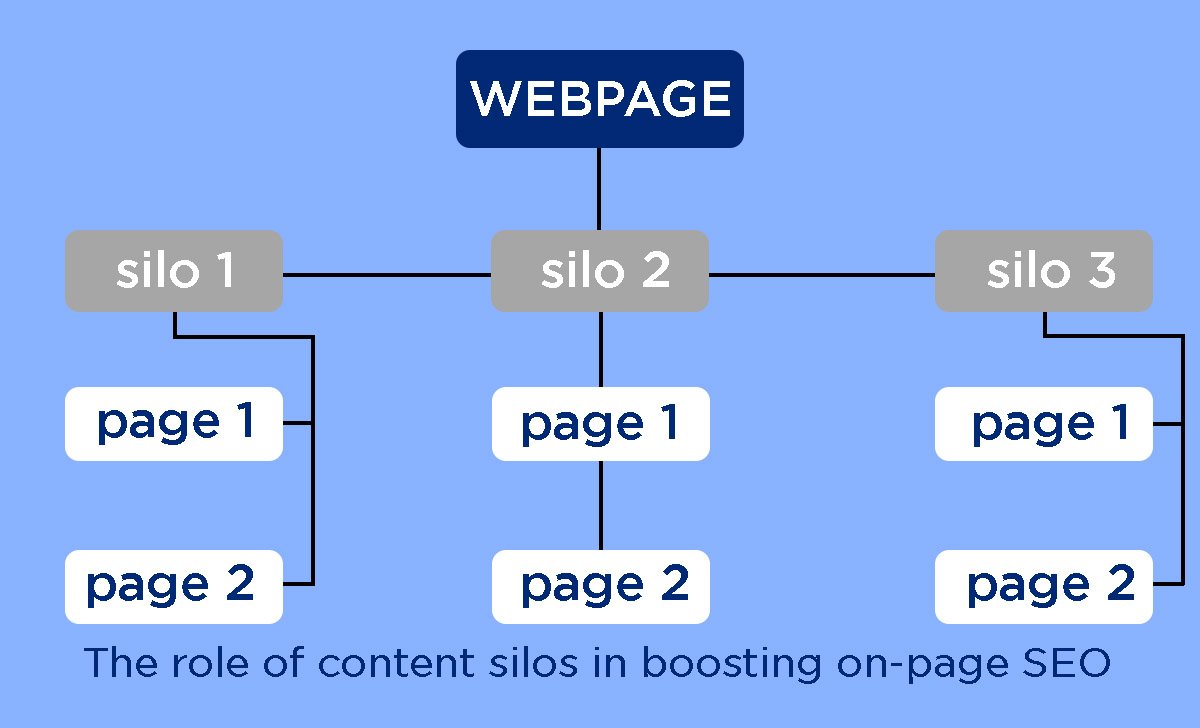- Delhi
- Last Update 08:19: am

The role of content silos in boosting on-page SEO
The word "silo" will always bring to mind the high tower used to store food grains. If you work in the content marketing industry, you may have heard of this term frequently and pondered how it applies to content marketing. In this article, we will explore the various methods to implement content silos, as well as how to structure your content and enhance your on-page experience using content silos.
What is your definition of content silos?
A content silo is a website structure that compiles or organises content in a structured format based on keywords. When initiating a content silo structure, you are essentially collecting pertinent content in distinct categories in a structured manner.
The purpose of creating content silos is to provide visitors, users, or robots with a superior, unique structure for the flow of information and to improve the website's overall performance and search engine optimisation by implementing keyword themes.
A content silo structure is more effective for both consumers and search engines. This makes it easier for them to locate or traverse the website's related topics and information. This will aid in increasing efficacy and organising information or data according to pertinent categories or keywords.
How important is Content Silos in SEO?
Content silos are the most essential aspect of SEO because they help users and search engines comprehend the overall content of your website. They desired to know what it was about, how it was organised, and its location.
This will not only help improve your SEO strategies, but it will also increase their usability. Some websites may appear to cover multiple topics with irrelevant or discordant content, which is an excellent example of a disjointed collection of content.
With the aid of content divisions, a website's content that is well-maintained also helps to drive traffic and improve website engagement over time.
The significance of content silos in SEO stems from the fact that robots and search engines place a greater emphasis on keyword relevance on web pages and websites. In other words, if I want to rank for the search term "soft drink," I should not include this keyword in a single page of content but rather construct a separate set of pages covering topics related to this keyword. This type of timely content will unquestionably assist in enhancing the overall authority of a page or website.
A step-by-step implementation instruction for Content Silos on a website.
To create a successful content silo structure, it is essential to comprehend your website's goals and objectives and to map or classify your related content topics accordingly. With proper information planning and execution, you can create content divisions that assist your website in achieving its goals and objectives.
Planned Constructive Content:
A strong and relevant content ideation plan will help you answer queries such as, "Who will be responsible for creating the content structure?" What kind of content structure will you develop? How frequently will you create new content? How will the content be distributed? On what criteria will you measure the effectiveness of your content?
A trustworthy and interconnected content structure will not only save you time but also assist you in achieving your objectives. The ability to avoid duplicate content is one of the most essential aspects of planned, constructive content creation. When you are ready to produce content, you can also develop a production strategy and delegate the responsibility for creating and maintaining content.
Convenient Keyword Research:
Before beginning content creation, it is necessary to conduct keyword research. Keyword research enables the identification of various categorizable topics for inclusion on a website. In addition, keyword research is regarded as an essential component of content strategy or writing. Implementing keyword research accurately will help you identify various keyword intents, such as informational, transactional, commercial, etc. In addition, it helps you determine your target audience and the keyword search volume.
It is essential to take a holistic approach when determining and analysing the types of keywords during keyword research. You must not only identify singular keywords, but also multiple phrases or silos that reflect your related topics. By focusing on silos rather than individual or singular keywords, you can achieve a higher ranking in the search engine results page by covering other related topics or keywords. Effective keyword research will allow you to increase organic traffic and assist you in converting users into customers.
Implement Virtual and Physical Silos:
There are two varieties of content silos: virtual silos and physical silos.
Virtual Content Silos: Virtual content silos are created by interlinking topic-related or pertinent pages on your website.
Physical Content Silos: Physical content silos are created by combining multiple pages with similar topics based on their physical locations. For example, a blog subdomain or another website
Both silos can be used to create content silos, and each has advantages and disadvantages in relation to content creation. In terms of search engine optimisation, creating content silos without including virtual and physical silos is ineffective.
Optimize Content:
Unique and high-quality content are the two most important ranking factors. Including a blog section on your website will facilitate the optimisation of vast quantities of content. The incorporation of blogs into your niche will undoubtedly increase traffic, but this will only be possible if your website is regularly crawled by search engine spiders. Ultimately, attracting more visitors, users, and potential consumers to the website will be beneficial.
In addition, it is essential to interlink your blog pages with other website pages, as it serves no purpose to create virtual or physical compartments. In addition, it will affect not only your crawl rate but also the number of visitors to your website.
Improving Internal Linking:
Internal linking is the most essential method for search engine crawlers, visitors, and users to navigate within a website. Internal linking is another method for guiding search engine robots to identify important pages by providing pertinent anchor text and links to relevant topic pages. To maximise the effectiveness of your content segregation strategies, you must implement accurate internal linking opportunities.
Have you ever contemplated how you could link your other topic-related pages? Simply connect all the topic-related pages within one silo to another silo using internal links. You should not link an internal topic from another silo to your current silo. Best practice dictates that only your homepage should exist outside of your division. According to experts, linking outside of your compartment may confuse search engine crawlers.
Errors while implementing Content Silos on a Website and How to avoid them?
A content silo structure defines the website's overarching content architecture. The content compartment can be very effective at generating traffic and overall search engine rankings if it is implemented correctly. This article will examine how errors can occur when implementing or executing content silos on a website.
Bunch of Silos:
Some individuals may create or develop numerous content silos, which can exacerbate perplexity and make a website or blog appear disjointed. And another factor could be that the content is not so extensive that content silos can be created.
Keyword Stuffing:
Keyword stuffing is one of the most common mistakes made when composing content, and incorporating too many keywords into the text harms page rankings.
Cross-Linking Opportunities:
Related material. This will deter visitors from discovering additional pages with relevant content. Additionally, the search engine indexes the content.
The ideal method for avoiding content silos is to have a comprehensive understanding of a piece of content. While creating a singular content silo, exercise caution. You should be cognizant of the purpose of the content silo. Goals include the quantity of content, the selection of relevant keywords to target, and the development of a structure that engages readers and encourages further exploration of related topics. By focusing more on cross-linking between the topic-related silos, it is possible to avoid common content siloing errors.
Conclusion:
Perfectly executed content solis divisions will help a website achieve a higher ranking and be more visible to crawlers and the intended audience. The content compartment is an essential component of on-page activity. Since you are now well-versed in content divisions and their general applications, you can apply what you have learned.









